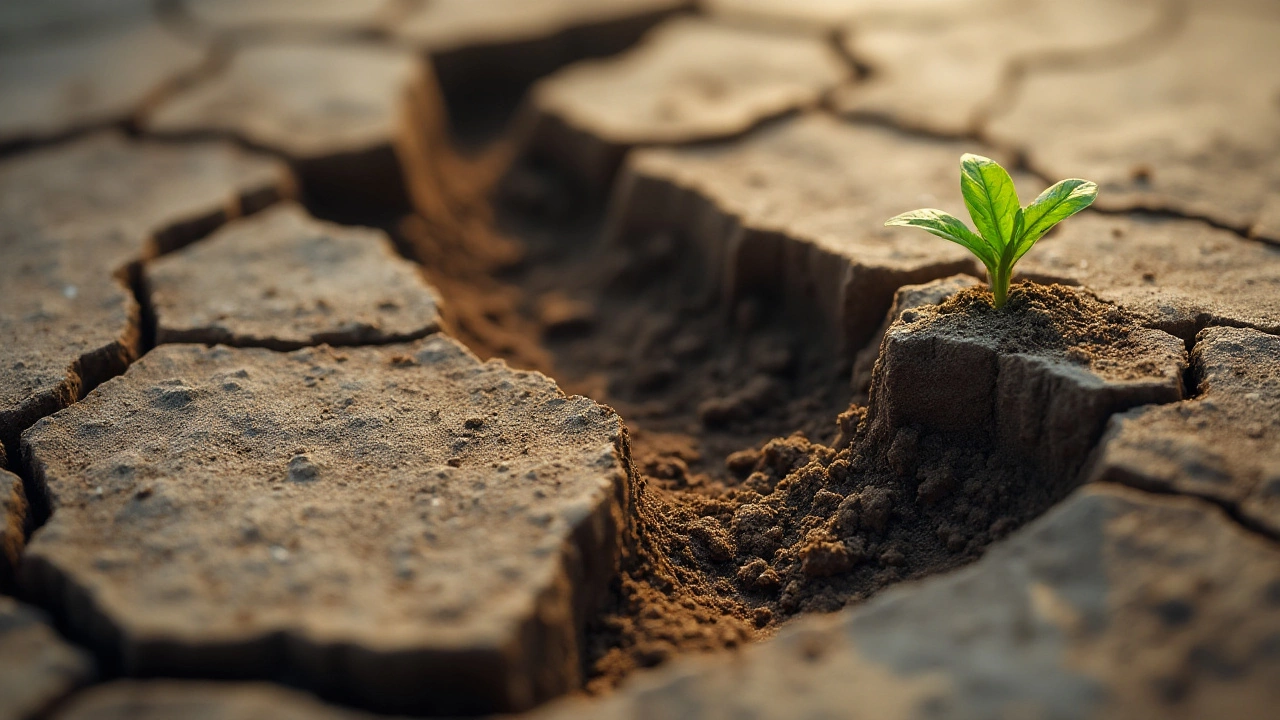For anyone who owns a home, the integrity of their foundation is paramount. It's what holds everything upright, quite literally. But what happens when this critical structure shows signs of strain or worse? Can a foundation be beyond repair?
Let's dive into the world of foundations and explore what causes these essential structures to falter. We'll look at common signs indicating a foundation is in trouble, and importantly, how repair professionals assess whether a repair is feasible. While some damage may sound catastrophic, rest assured that solutions often exist. By understanding potential issues early and seeking professional advice, you might find that even seemingly impossible foundation problems have solutions.
- Understanding Foundation Problems
- Common Causes of Foundation Damage
- Signs Your Foundation Needs Attention
- Evaluating Repair Possibilities
- When Repair Seems Impossible
- Pro Tips for Foundation Maintenance
Understanding Foundation Problems
Foundations are the bedrock, quite literally, of any building, supporting the entire structure and ensuring it stays upright. However, when we discuss foundation problems, we're not just talking about visible cracks or that doozy where the door doesn't close properly. It's a world of its own, where structural damage can have causes that aren't immediately obvious to the naked eye. One might wonder how something so solid could ever falter. The truth is, several factors could contribute to foundation issues, ranging from soil conditions to water management. Understanding these can help prevent small issues from ballooning into unfixable nightmares.
One of the major culprits behind foundation issues is soil. Different types of soil expand and contract based on moisture levels, which can heavily impact the stability of a building's foundation. Clay soil, known for retaining water, can expand significantly, putting immense pressure on the foundation. On the contrary, during dry spells, this soil can shrink, leaving gaps beneath the foundation, which may cause it to sink. Another factor is construction practices; sometimes, the fault lies in the initial laying of the foundation, whether it’s too shallow or lacking proper materials. Each foundation repair expert must consider these elements before determining the best course of action.
Homeowners should be aware of the signs that a foundation could be in trouble. These signs include cracked walls, uneven floors, and misaligned doors or windows. Sometimes, one might notice gaps forming in caulking or moldings. Something as simple as a hairline crack might seem unimportant, but given time, such cracks can widen and compromise the entire structure. Water pooling around the foundation during rains is another red flag, indicating poor drainage, which needs addressing before severe damage occurs. For the keen-eyed homeowner, these early indicators can save significant stress and expense down the line.
"An ounce of prevention is worth a pound of cure," as Benjamin Franklin once remarked. This definitely applies to foundation issues. Addressing them promptly can protect not just the building but its market value.
Investing in regular checks by professionals can be crucial. They can assess the foundational stability efficiently and identify potential problems early. For instance, yearly inspections can reassess previous issues and ward off new ones. By establishing a relationship with a trusted expert, homeowners can take a proactive approach. Not only does this maintain the safety of the home, but it can also safeguard its property value, an often underestimated consideration for homeowners planning to sell in the future.
Common Causes of Foundation Damage
Every homeowner dreads discovering that their home's foundation is in trouble. Yet, understanding what causes foundation damage can be a game-changer in mitigating potential problems. One of the primary culprits is poor construction, where shortcuts and cost-cutting measures lead to inadequate soil preparation or substandard materials. This sets the stage for future issues as the structure lacks a solid base from the get-go. Another significant player is the soil on which your home sits. Expansive clay soils are notorious for swelling when wet and shrinking upon drying. This cycle of swelling and shrinking leads to soil instability, which can push against the foundation, causing cracks and shifts. Sometimes, a blend of these factors works against your home's foundation, leading to complex repair challenges.
Another cause that silently jeopardizes your home’s foundation is water. Improper drainage can allow water to pool around your foundation, leading to soil erosion and shifting—two foes no foundation can withstand for long. Heavy rainfall, plumbing leaks, or burst pipes can saturate the soil, leading to excess pressure against the foundation walls. This often results in cracks and water seeping into the basement, creating a damp environment that's perfect for mold growth. As dangerous as it sounds, it happens more often than one might think. Failed water management systems exacerbate the problem, turning a manageable issue into a costly nightmare. In some cases, seismic activity, although less common, can also contribute to foundation damage. The shifting earth during an earthquake affects the stability of your home, potentially causing cracks or worse.
Tree roots can be an unexpected but potent menace. Planting trees too close to the house might seem harmless, yet as they grow, their roots seek moisture. In their search, they naturally gravitate towards the foundation, sometimes finding entry points in weakened areas. Once they invade, they can exert pressure that causes cracks. While trimming or removing roots addresses short-term issues, sometimes the foundation needs a more comprehensive fix. Similarly, poor landscaping decisions, such as installing flowerbeds against the foundation or sloping soil toward the house, can exacerbate moisture problems. These seemingly innocent actions over time lead to significant structural damage that impacts the overall stability and integrity of your foundation.
"The foundation to your home is like the roots to a tree. Protect the foundation and you'll protect the home," says a renowned foundation expert John Adkins.
Inadequate foundation design also plays a role in potential failure. When homes are built on various types of soil or with a lack of foresight about moisture exposure, the foundation may be doomed to troubles down the line. As gravity relentlessly tugs at your home, it demands structures that flex with shifts yet stand robust against pressure. Foundations that were tailored without consideration of such natural evolution might ultimately succumb to shifts or erosion. A related issue is improper installation of utilities. Plumbing and electrical systems installed too deeply against the foundation can not only disrupt its integrity but also pave the way for water intrusion and other damage. Addressing such problems often requires surgical precision to avoid further destabilization while fixing the core issues.
As climate change advances, intense weather patterns including flooding and droughts become more frequent. These conditions stress foundations as they endure uncharacteristic cycles of rainfall and dry spells. Intensified wet periods swell the soil, leading to elevated water table levels that affect foundation stability. Distinct dry periods resulting in soil shrinkage can equally shift structures, producing cracks and misalignments. To navigate such weather challenges, smart landscaping and regular maintenance offering a proactive barrier prove invaluable. Moreover, some homes might also face predicaments from nearby construction activity or traffic vibrations. These external forces can induce minute tremors, causing hairline fractures that develop bigger over time.
Regardless of the stressors acting on your foundation, regular inspection and maintenance can alleviate the long-term consequences. By using preventative measures, such as proper landscaping and controlling moisture levels around your home, you help give your foundation the resilience it needs. Experts often recommend keeping an eye on warning signs like cracks in walls, sticking doors, or uneven floors as these can signal deeper foundation issues. The effects of foundation damage not only hinder home safety but can also decrease the overall property value. Regular professional assessments provide a clear understanding of the current state of your foundation and the proactive steps needed to ensure it remains sound, which preserves your invested time and funds in your beloved home.
| Factor | Impact Level | Common Mitigations |
|---|---|---|
| Poor Construction | High | Reinforcement, Retrofitting |
| Expansive Soils | Moderate to High | Soil Stabilization, Moisture Control |
| Water Drainage | High | Drainage Systems, Landscaping |
| Tree Roots | Moderate | Root Barriers, Tree Relocation |
| Climate Fluctuations | High | Moisture Management, Flexible Foundations |

Signs Your Foundation Needs Attention
Identifying the signs that your foundation might be in trouble is crucial to ensuring your home's safety and maintaining its property value. A keen eye and a bit of knowledge can save you from future headaches. One of the most conspicuous indicators is cracking. Cracks can appear in various places such as walls, floors, or ceilings. While small, hairline cracks are often normal due to settling, larger or widening cracks may suggest a larger issue. Pay close attention to doors and windows as well. If they start sticking or separating from the frames, this could be a sign of foundation shift. Your floors might also tell a tale; uneven or sloping floors are often a sign you're dealing with a foundation repair issue.
Another area to observe is the basement. Do you notice any moisture accumulation or water gathering in specific spots? A foundation might be compromised if water leaks are persistent, leading to dampness or mold growth. It's helpful to shine a light on your walls; any noticeable gaps can signal trouble. Sometimes, the exterior shouldn't be ignored too. Look for leaning or cracked chimneys that might be pulling away from the structure. This often acts as a red flag for deeper structural problems.
"Uneven floors and door misalignment are significant indicators of foundational issues," warns John Miller, a renowned structural engineer specializing in foundation repair.
Infrequent or unexpected creaking noises might not just be the house settling over time. If you've noticed shudders and groans in conjunction with other symptoms, it's wise to consider a professional assessment. Additionally, pay heed to nails popping out from drywall; this usually indicates a shift in the foundation below. Sometimes, changes in landscape, such as swirling drainage away from the house, can exacerbate the damage to the foundation. If your home appears lower at certain points or if you notice misalignment in the roof ridges, these are often consequences of comprehensive failures beneath.
It's important not to panic if you detect some of these signs. Rather, knowledge is your best defense. Schedule inspections and repairs promptly to safeguard your home from what might become significantly larger structural damage. Sometimes the cost and effort involved in addressing foundation issues can seem daunting, but overlooking them can result in increased expenses and complexities down the road. After all, your home's foundation is both its literal and figurative base. Approach any home safety concerns with the respect, effort, and investment they deserve.
Evaluating Repair Possibilities
Determining whether a foundation repair is feasible requires a deep understanding of the problem at hand. It's not just about deciphering cracks or uneven floors but getting under the skin of the structure to see what's really going on. The process typically begins with a thorough inspection by professionals who have spent years learning the language that buildings speak through their silent shifts and quirks.
These experts will assess common issues, such as gaps around window frames or doors that refuse to close properly, as well as less obvious symptoms like sloped floors. They come equipped with tools and techniques, from laser levels to soil moisture testers, to understand precisely what is causing the structural damage. A crucial part of their job is to assess the soil conditions since shifting or sinking can often be traced back to the soil's movement. A foundation's best friend or worst enemy often lurks beneath the surface in the form of expansive clay or poorly compacted fill.
Repairing a damaged foundation often involves comparing different methods and materials before deciding what's most appropriate. Options could range from installing piers to stabilize and lift the foundation, to underpinning with concrete or steel, or even utilizing more modern techniques like polyurethane foam injections. The choice of method will depend heavily on the specific type of damage, its extent, the seasonal climate effects, and of course, the budget available.
"A home is only as sound as its foundation," says renowned structural engineer Dr. Samuel Hawkins, emphasizing the critical nature of early intervention.
So, how does one know if repairs are economical or even possible? It often boils down to an analysis of cost versus benefit. Sometimes, the cost of foundation repair can be dwarfed by the potential increase in property value once the foundation is stable. Other times, it might make more sense to explore a different approach if the costs become prohibitive without sufficient return.
For an accurate diagnosis, expect a detailed report detailing the findings and recommended repairs, along with a clear cost estimate. Homeowners should be prepared for surprises as no two foundation problems are entirely alike. The hope, however, is to find a clear path to stabilizing your home without going for a complete overhaul. In some instances, minor adjustments over time, such as drainage improvements or minor crack sealing, might suffice. For those looking to understand their foundation repair better, consulting with multiple professionals to gather diverse opinions can provide insights that might otherwise be overlooked.

When Repair Seems Impossible
Encountering a foundation problem that seems beyond repair can evoke a mix of dread and confusion for any homeowner. The specter of irreparable damage looms large, but understanding how to approach these situations is crucial. Structural damage often appears insurmountable due to a variety of factors, such as the extent of deterioration or the nature of the underlying soil. For instance, if a foundation has undergone severe subsidence due to soil erosion or expansive clays, conventional methods—like pier installation or underpinning—might fall short. In such cases, the costs can skyrocket, and the successful restoration of stability is not always guaranteed.
Foundations built on inappropriate soil types often encounter these seemingly impossible repair scenarios. Soils that expand and contract significantly with moisture, like expansive clay, can dramatically alter the stability of structures. These soil movements can lead to issues that defy simple fixes. A home might begin to tilt similar to the famous Leaning Tower of Pisa, trapping homeowners in dilemmas about the practicality and worth of intervening. "In certain regions where clay content or soil moisture variation is significant, only proactive designs or radical interventions can ensure stability," remarked a senior geotechnical engineer from a leading construction firm.
Even when the foundation itself is heavily compromised, hope isn't entirely lost. High-tech solutions like hydraulic jacking or helical pier systems may offer salvation. But it's vital to analyze whether the value of the property justifies such expenses. It's essential to work closely with engineers who specialize in geotechnical challenges. Solutions can be intricate, often requiring analysis of soil samples and stress testing. But when the structure in question holds great personal or historical value, the investment may feel worthwhile.
Real estate and insurance play pivotal roles when assessing the feasibility of repairing a foundation that seems unfixable. The impact on property value can be significant, especially when major deformities are involved. This complexity is compounded further in older buildings where traditional construction techniques were utilized. Here, a detailed inspection might uncover legacy issues tied to aging materials or past seismic activities, complicating the prognosis further.
In some regions, statistical data has shown that nearly 10 to 15% of homes suffer from profound structural damage within 20 years if built on sensitive soils without adequate precautions. Homeowners looking to preemptively safeguard their investment might consult a specialized architect or structural engineer to explore potential design modifications. This might include reinforcing critical load-bearing elements or realigning misaligned sections to mitigate risks associated with catastrophic failure.
Pro Tips for Foundation Maintenance
Maintaining a healthy foundation is crucial to the longevity and safety of your home. It's essential for homeowners to stay proactive in their approach to maintenance, ensuring that small issues don't spiral into major problems that could compromise the structural integrity of their property. The journey to a stable foundation begins with understanding the signs of trouble and implementing regular inspections.
Regular inspections are vital. When conducted twice a year, they can reveal early warning signs often missed by the untrained eye, such as hairline cracks in the foundation, gaps in window frames, or uneven flooring. These subtle changes can indicate that your foundation is shifting or settling, a process that, if left unchecked, could lead to significant damage. An inspection should also focus on drainage systems, as poor drainage is one of the main offenders when it comes to foundation issues.
Speaking of drainage, ensuring proper water management is indispensable. Water can be a foundation's worst enemy, leading to soil expansion and contraction that can wreak havoc on even the most robust structures. Installing or maintaining gutters and downspouts that direct water away from the home is a simple yet effective strategy. Regularly check for blockages, especially during fall and winter, to prevent overflow that soaks into the soil around the foundation.
A balanced moisture level around your foundation is crucial. In extremely dry climates, soil can shrink and pull away from the foundation, causing it to settle unevenly. Conversely, overly saturated soil can apply pressure to the walls. Using a soaker hose around your home, especially during dry spells, helps maintain moisture balance, reducing the risk of damage due to soil movement.
"A well-maintained foundation is synonymous with a well-maintained home. It's the hidden hero that holds it all together," says Henry Suarez, a noted structural engineer with over 20 years of experience in the field.
Finally, be mindful of nearby trees and their root systems. While trees add beauty and value to your property, their roots can extend far and wide, searching for water, often beneath your carefully tended foundation. When planting trees, consider their mature size and distance from the home. A good rule of thumb is to plant trees as far from the foundation as their expected full height. This simple step can prevent roots from disrupting the soil under your home and causing shifts.
Maintaining your home’s foundation isn't just preventive; it’s a savvy financial move. The expense of repairing foundation damage can far exceed the cost of these consistent maintenance efforts. And remember, professional inspection services are always an option when internal assessments feel insufficient. Taking these steps seriously will ensure your home not only stands firm in the present but remains a resilient refuge for years to come.




Write a comment